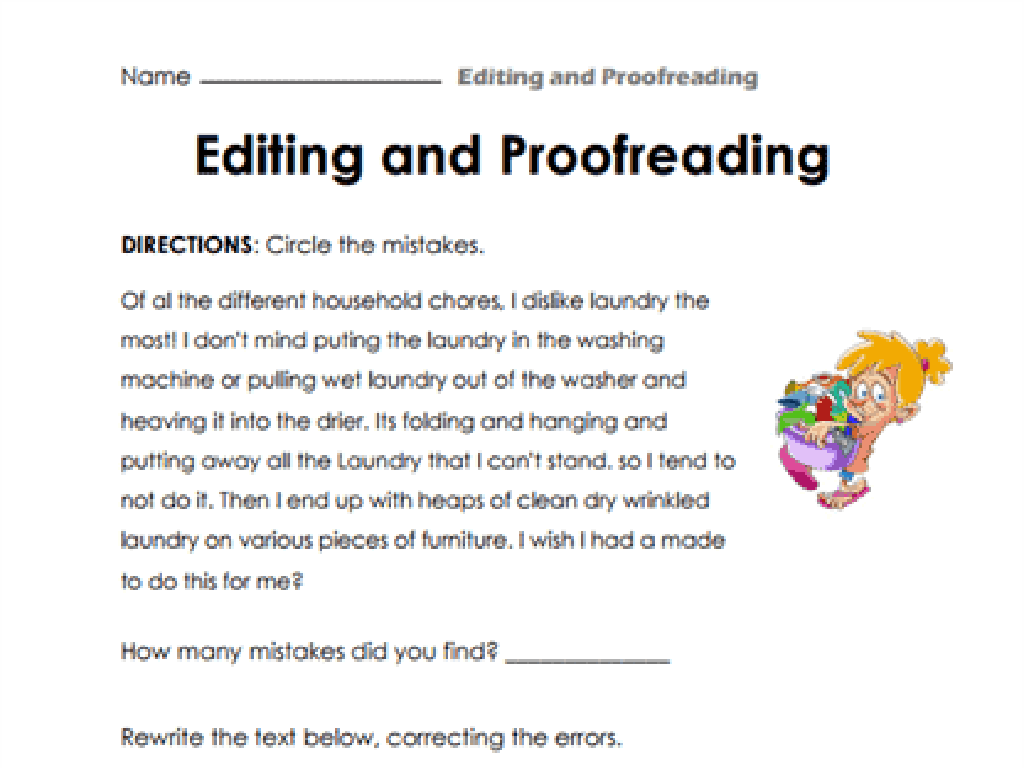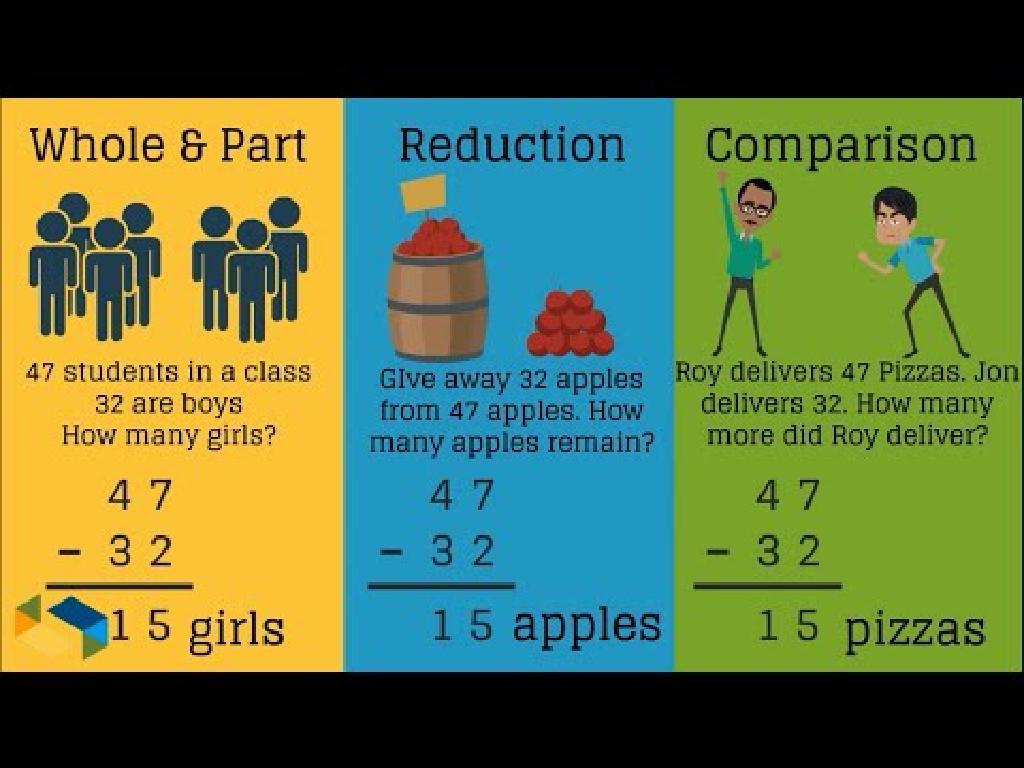Positive And Negative Connotation
Subject: Language arts
Grade: Fifth grade
Topic: Shades Of Meaning
Please LOG IN to download the presentation. Access is available to registered users only.
View More Content
Positive and Negative Connotation
– Connotation shapes meaning
– Words carry feelings beyond dictionary definitions
– Positive vs. Negative connotation
– ‘Slim’ feels positive, ‘Skinny’ can feel negative
– Word choice matters
– Choosing words can change how others feel
– Impact of words on communication
– Words can build up or hurt, affect friendships
|
This slide introduces the concept of connotation, the idea that words carry additional implications and emotions beyond their literal meanings. Discuss how a word’s connotation can be positive (like ‘slim’) or negative (‘skinny’), and how this affects the message being conveyed. Emphasize the importance of choosing words with the right connotation to communicate effectively and kindly. Provide examples and ask students to consider how different word choices might change the feeling of a sentence. This will help them understand why it’s important to think carefully about the words they use, especially when writing stories or expressing their thoughts and feelings.
Understanding Connotations in Words
– Connotation: emotional/cultural meaning
– Words carry feelings and ideas that people associate with them.
– Beyond dictionary definitions
– Words have a literal meaning, but connotations add extra flavor.
– ‘Home’ vs. ‘House’: Feel the difference
– ‘Home’ suggests warmth and family, while ‘house’ is the physical structure.
– Impact of connotation on communication
|
This slide introduces the concept of connotation, which is crucial for understanding the emotional and cultural nuances words can carry. It’s important to explain that while words have their basic, literal meanings, connotations can greatly affect how we perceive those words. Use ‘home’ and ‘house’ as examples to illustrate how similar words can evoke different feelings; ‘home’ often implies comfort and belonging, whereas ‘house’ might feel more impersonal. Discuss how choosing words with the right connotation can change the tone of communication. Encourage students to think of other word pairs with different connotations and how they might use them in their writing and speech.
Understanding Connotations: Positive Words
– Positive connotation feels good
– Creates a positive impression
– ‘Slim’ vs. ‘Skinny’: a comparison
– ‘Slim’ implies attractiveness, ‘Skinny’ often less favorable
– Impact of positive language
– Positive words can influence thoughts positively
|
This slide introduces the concept of positive connotation to the students, emphasizing how word choice can affect feelings and impressions. Highlight the difference between words like ‘slim’ and ‘skinny,’ where both refer to a similar physical trait but carry different emotional weights. ‘Slim’ often has a positive connotation, suggesting an attractive thinness, while ‘skinny’ can imply being too thin in a less favorable way. Discuss how using positive language can influence our thoughts and the way we perceive others. Encourage students to think of other word pairs and how their connotations differ. This will help them understand the power of words and how to use them effectively in writing and speech.
Understanding Negative Connotations
– Negative connotation effects
– Words can make us feel bad or uneasy
– Creating a negative impression
– They can influence our perception negatively
– ‘Cheap’ vs. ‘Inexpensive’
– ‘Cheap’ may imply poor quality, while ‘Inexpensive’ suggests affordability without losing quality
– Impact on communication
|
This slide aims to teach students about the power of word choice and how negative connotations can influence the tone and perception of a message. Discuss how certain words can evoke negative feelings or impressions, and how this can affect communication. Use the example of ‘cheap’ versus ‘inexpensive’ to illustrate how similar meanings can have different emotional impacts. ‘Cheap’ might suggest something is of low quality and not worth much, whereas ‘inexpensive’ simply means it doesn’t cost a lot, without the negative quality judgment. Encourage students to think of other word pairs and discuss the connotations of each. This will help them understand the importance of choosing words carefully to convey the right message.
Shades of Meaning: Connotations
– Positive vs. Negative Connotation
– Words can have a good (positive) or bad (negative) feeling
– ‘Childish’ vs. ‘Youthful’
– Discuss with a friend how these words feel different
– Find words with different connotations
– Think of words that sound similar but feel different
– Share your ideas with the class
|
This slide introduces the concept of connotation to the students. Begin by explaining that words carry feelings and those feelings can be positive or negative. Use ‘childish’ and ‘youthful’ as examples to show how similar words can have different connotations; ‘childish’ often has a negative connotation implying immaturity, while ‘youthful’ has a positive connotation implying liveliness. Encourage students to pair up and discuss why these words may have different connotations. Then, as a class, brainstorm other words that have similar meanings but carry different emotional weights. This activity will help students understand that word choice can affect the tone and meaning of their writing. Provide guidance and examples as needed to facilitate the brainstorming.
Choosing the Right Word: Connotation
– Authors’ choice of words
– Words carry feelings; authors choose carefully to convey the right emotion.
– Connotation’s impact on message
– Words with similar meanings can have positive or negative feelings attached.
– Activity: Positive vs. Negative
– Write a sentence with a positive word, then change just that word to a negative one.
– Understanding word impact
|
This slide introduces the concept of connotation and how word choice can affect the reader’s perception. Explain that connotation refers to the emotional or cultural association with a word beyond its literal meaning. Discuss why authors might choose words with a certain connotation to influence the reader’s feelings or attitudes towards a subject. For the activity, guide students to understand how the connotation of words can change the tone of a sentence. Provide examples and encourage creativity. For instance, ‘The performer was confident’ versus ‘The performer was arrogant.’ This exercise will help students see the power of words and their connotations in shaping meaning.
Class Activity: Connotation Creation
– Pick a scenario in groups
– Write two descriptions
– One description should have a positive tone, the other a negative tone
– Use positive and negative connotations
– Positive connotation: joyful, Negative connotation: unpleasant
– Share and discuss with the class
|
This activity is designed to help students understand the concept of connotation in language. By working in groups, they will choose one of the provided scenarios and write two different descriptions of the same event, one using words with a positive connotation and the other with a negative connotation. This will illustrate how word choice can change the tone and emotional response to a description. After writing, each group will share their descriptions with the class, and a discussion will follow on how the different words used affected the overall impression of the scenario. Possible activities: 1) Comparing the emotional impact of the two descriptions, 2) Voting on which description the class prefers and discussing why, 3) Creating a word cloud of positive and negative words from all the descriptions, 4) Writing a neutral description and then altering it to be positive or negative.
Connotation: Conclusion & Reflection
– Importance of understanding connotation
Connotation affects our emotions and thoughts about words.
– Connotation in our communication
Knowing connotation helps us choose words wisely to express ourselves better.
– Homework: Detect connotation in reading
Find words with a strong feeling or idea they suggest, besides their literal meaning.
– Reflect on connotation usage
|
Understanding connotation is crucial because it shapes our perception and can influence others’ emotions and thoughts. It’s the difference between calling someone ‘slim’ versus ‘skinny’ – the words may have similar dictionary definitions, but their connotations evoke different feelings. By being aware of connotation, students can become more effective communicators, choosing words that convey the right emotions and avoiding misunderstandings. For homework, students should find examples of positive and negative connotations to reinforce their understanding. In the next class, discuss these examples to reflect on how connotation is used in literature and daily communication.






